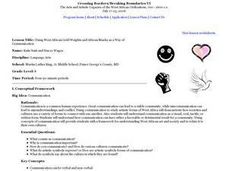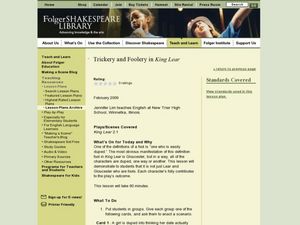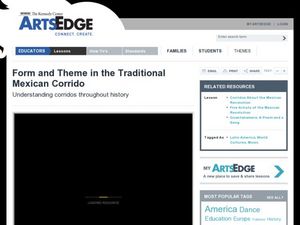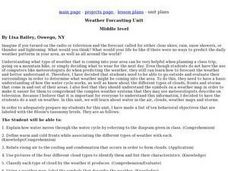Curated OER
What Makes Good Literary Writing?
Learners conduct a literature study of John Steinbeck's classic "Of Mice And Men". They write in reflection of the author's influence upon 20th century literature. Students take apart the story to focus class discussion upon major themes...
Curated OER
Using West African Gold Weights and African Masks as a Way of Communication
Eighth graders discuss how communication, or lack thereof, can have either a favorable or detrimental effect on a community. They study and interpret proverbs as a means of teaching a lesson. Finally they discuss symbolism and design a...
Curated OER
Idioms Lesson Plan
Sixth graders discover idioms. For this idioms lesson, 6th graders evaluate idioms and discover their meaning. Students read Runny Babbit by Shel Silverstein and create unique idioms. Assessment rubric is provided.
Curated OER
Poetry: Techniques & Form
Ninth graders explore poetic technique and figurative language in this ten lesson unit. Comparisons are made between a variety of forms of poetic expressions and the lives of several poets are studied.
Curated OER
Trickery and Foolery in King Lear
Students act out scenarios in which someone is duped or is made a fool of. In this trickery and foolery in King Lear lesson, students plan and act out a brief scenario and discuss the person who is duped and why. Students...
Curated OER
Macbeth Presentations
Students make Powerpoint presentations or Web pages about Macbeth. Their presentations must include at least three elements from a provided list. They write reflective papers about their learning experience.
Curated OER
Rhymes
Students complete rhyming word activities. For this rhyming words lesson, students play an online game for rhyming words and recite a well known nursery rhyme as a class. Students pick out words from the poem that rhyme and brainstorm...
New York City Department of Education
What Did I Do to Be so Black and Blue: How Did Jazz Influence Ralph Ellison's Invisible Man
How did jazz influence Ralph Ellison's Invisible Man? Class members read some of Ellison's non-fiction writings about blues and jazz, listen to records, watch videos, and engage in student-centered discussions. They then produce podcasts...
Curated OER
Quirky Quatrain Poetry Lesson
Middle schoolers discover what a quatrain is, and are taught the three poetic devices: alliteration, hyperbole, and onomatopoeia. Everyone chooses a favorite hobby or activity, then attempts to write a poem about it. They must write two...
Curated OER
Lesson 1: Faulkner's The Sound and the Fury
I love Faulkner, his experimental style and stream of consciousness are so exciting. Your learners can analyze William Faulkner and his novel, The Sound and the Fury by defining his place in American literary history and exploring...
Curated OER
Today’s Telephone
Does your class know the history behind today's telephone? They will after reading a very interesting one-page informational passage. They'll learn all about the way phones have progressed to the amazing devices they've become as they...
Curated OER
Form and Theme in the Traditional Mexican Corrido
Students examine the traditional Mexican musical form of corridos. In this cross curricular history and music lesson, students analyze the lyrics of popular corridos and the corridos' importance in Mexican culture. Students will...
Curated OER
Weather Forecasting Unit
Middle schoolers study weather concepts, mapping, characteristics in this series of lessons.
Curated OER
A Creative Presentation
Young scholars read chapter books by Gary Paulsen. In groups, they identify imagery presented in the book. Students locate 10 quotes, categorize each quote into one of the five senses, and then organize it and create a display of their...
Curated OER
Element Names
In this chemistry worksheet, 10th graders write the name for each of the 12 chemical element symbols that are shown in the chart.
Curated OER
Political Cartoons: Thinking Broadly, Communicating Succinctly
Students think broadly about the tsunami disaster and its aftermath through studying cartoons. Students critically think about the literary devices the authors/artists use, such as satire, metaphor and personification.
Curated OER
Cartoon Analysis Worksheet
In this cartoon analysis instructional activity, students fill out the instructional activity to assist in the analysis of cartoons. They consider symbols when determining the message of the cartoon.
Curated OER
Looking at Life through the Creation of Personal Metaphors
Students focus on the creation of personal metaphors, which are first illustrated in pictures and caricatures and then extended to descriptive/analytical paragraphs. They teach the lesson to others using their own personal metaphors as...
Curated OER
Author Study
Students examine and identify the characteristics of the different genres of literature. After being read and reading various stories, they identify how different books by the same author carry the same story elements. They discuss how...
Curated OER
The Secret Garden
Students explore plants in science and England as they synthesize data from the book, "The Secret Garden in this twelve lessons unit. Comparisons between the nuturing needs of plants and humans are made.
Curated OER
Our Neighborhood
Students inspect visual arts by analyzing their hometown. In this neighborhood instructional activity, students identify the different buildings, topography, landmarks and scenery near their home. Students utilize art products such as...
Curated OER
Lines Composed a Few Miles Above Tintern Abbey
Twelfth graders read lyrics for "My Hometown" and complete a worksheet to identify setting and tone in the song. In this Romanticism lesson, 12th graders read Lines Composed a Few Miles Above Tintern Abbey by Wordsworth and discuss...
Curated OER
The Keith Haring Car
Students examine Keith Haring's artwork. In this art lesson, students paint a car using his style of art known as Pop Art.
Curated OER
Artistic Symbols
Students compare and contrast symbols used in African and Plains Indian art. In this visual arts lesson, students compare symbols of 2 cultural groups found in their art. Students write a description of what items might have been left...

























